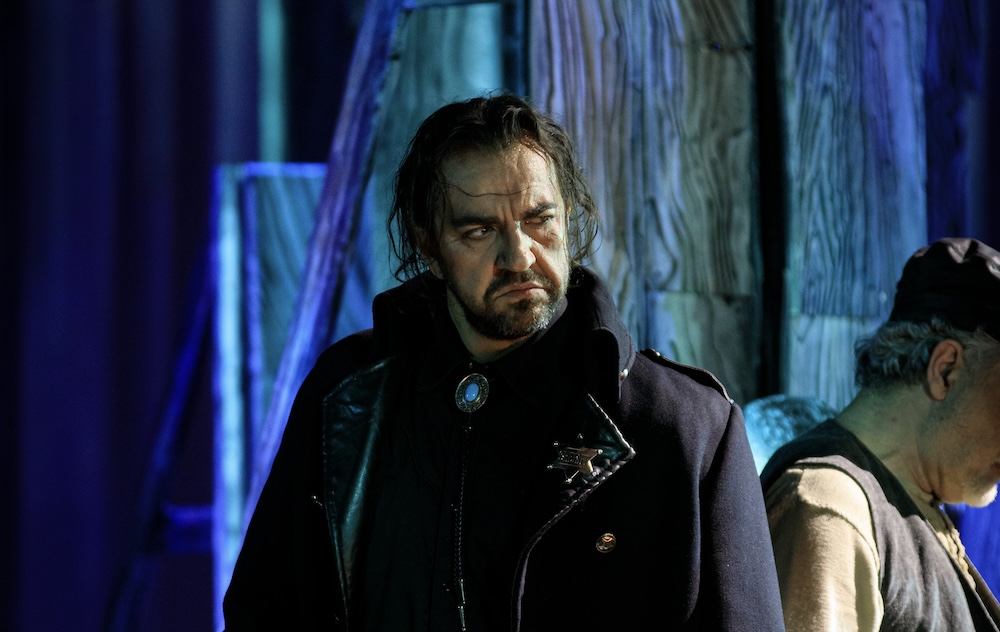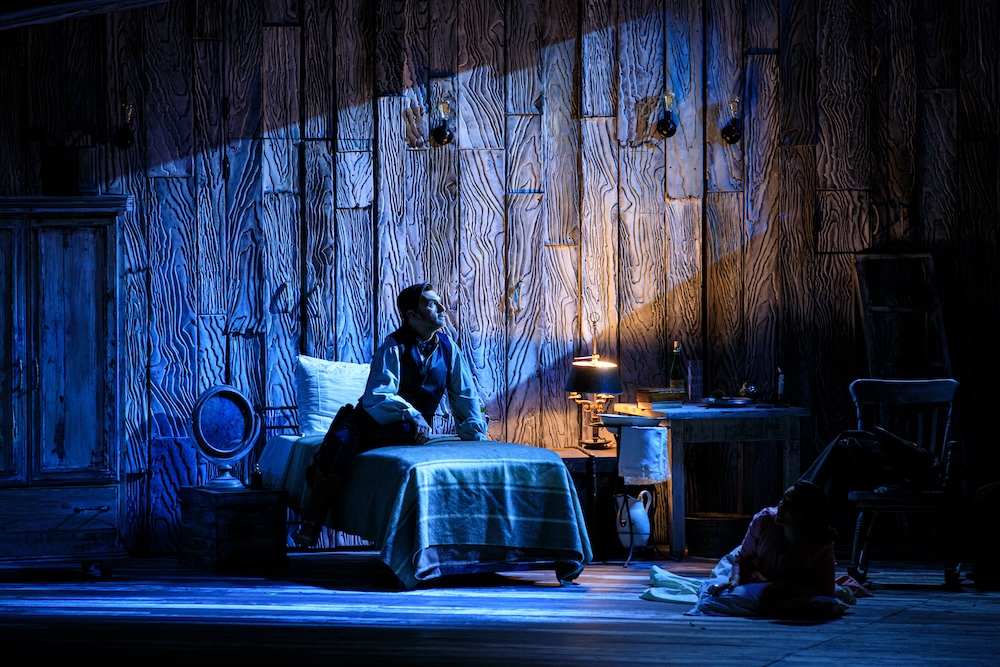Banished for the moment from its historic 1763 theater (closed for the renovation of its public areas) the prestigious Teatro Comunale di Bologna finds itself at the Comunale Nouveau [sic], a convention style theater that is a part of the red city’s massive, ex-centric fairgrounds.
Unfazed by its theatrically primitive surroundings the Teatro Comunale mounted a new production of Puccini’s 1910 La fanciulla de West by Scottish director Paul Curran [who resides in Palm Springs, California]. Of utmost simplicity, Mr. Curran’s staging places absolutely no political or social perspective on San Francisco playwright David Belasco’s early 20th century, naturalistic scenario. Stripped of any overlay it revealed only the most obvious tenets of Italian tradition as proposed by Puccini’s librettists — an idealized feminine purity, an idealized male libidinous force, idealized true love, not to overlook all powerful maternal love and the brotherly spirit of a horde of “ragazzi” (guys).
Structured much like its immediate predecessor, Madama Butterfly, Fanciulla’s first act closes with a love duet, and like Tosca as well (composed just before Butterfly) the second is in an intimate space and the third act is an execution. Reduced to its essentials the Curran staging clearly revealed Fanciulla’s dramaturgical roots.
Once our ears adjusted to the harsh sound of this conference style theater, conductor Riccardo Frizza took us to a similar place, where the inherently musical force of the Italian language shown forth in intonation and phrasing, where the flow of action was subservient to the musicality of the larger phrasing, and where the emotive musical moments were themselves the action. It was this sort of interpretive minimalism that crowned the evening, insisting that Puccini’s opera be no more than itself.
And this was the evening’s triumph, it was Puccini’s La fanciulla del West, his pentatonic scales signaling generic exoticism, not Butterfly’s Asian setting, his quintessential Italian musicality in the service of a purely Italianate story.

The story was not even in California 49er Gold Rush clothing. Though Irish designer Gary McCann did use wood planks (what else) to make Minnie’s Gold Rush saloon, the same planks were reconfigured to be Minnie’s cabin, and then were pulled apart to make the tree trunks for the third act forest. The costumes were said to be updated, explaining Minnie’s simple red dress, but leaving us puzzled about Dick Johnson’s trench coat. Jack Rance, in chic black, had a great big gold star on his chest, but you could not miss him anyway because this sheriff, like the law, towered over everyone.
Baritone Claudio Sgura, only too willing to wager his duty against his lust for Minnie, has made this Gold Rush sheriff his signature role on the world’s major stages. Of imposing stature and fine, well-schooled voice he perfectly embodies a larger-than-life Italian male ideal. Though in this Bologna staging he had nothing more to do after the miners saved Dick Johnson’s neck. So he just stood there — at least Mr. Sgura was required to kill himself in a recent Lyon staging.
Soprano Carmen Giannattasio (lead photo), played a very convincing Minnie. Though she is a full-blown diva (Tosca is a signature role), and Minnie is a role often exploited by famed dramatic voices, this Minnie immersed herself in the larger musicality of the evening, embodying the chaste Minnie, the queen of the miners Minnie, as well as the Virgin Mary Minnie who offers the miners maternal love and spiritual guidance. Mme Giannattasio found all the nuances of her complex character in her very Italianate, spinto vocal colors.
Like Tosca, Fanciulla’s second act holds the moments of the opera’s greatest tension (though far less brutally). This Fanciulla act directly echoes Virgil’s The Aeneid, Book IV — a storm rages outside, while inside the cave Dido gives herself to Aeneas, beautifully and sensitively performed by Mme. Giannattasio and tenor Angelo Villari.

Mr. Villari played a convincing Dick Johnson from Sacramento. Though Dick is also the notorious Mexican bandit Ramerrez, said to frequent the notorious Mexican whore Nina Micheltorena. Mr. Villari’s career seems to be only in Italy though he possesses a voice and presence that is worthy of any of the world’s major stages. With fine, tenor heft and appropriate squillo he negotiated with Minnie to receive her very first kiss ever (these were Victorian times), In the end, noose around his neck, he made a moving appeal that Minnie believe him safe and far away, befitting the heavy sentimentality mined by the production.
The poker game with Dick’s life as the stake was the moment of violence, both players (Minnie and Jack) percussively slapping the table, extra-musically, their cards in hand, Puccini aggressively defining the brutality of the game in pauses and attacks. The scene was strikingly staged by Mr. Curran, the brilliance of the famed orchestra of the Teatro Comunale di Bologna was quite apparent.
The cameo scene played at the beginning of Act II by Wowkle (Elonora Filipponi) and Billy Jackrabbit (Shibin Zhang) was not integrated into the production. It came from nowhere and went nowhere.
The opera’s first act and last acts are the domain of the miners of which twelve are named roles. Puccini pays much musical attention to the loneliness of their lives, here staged with dripping sentimentality that won us over, the maestro pulling wrenching warmth from their choruses, the male chorus of the Teatro Comunale immersed in their roles. Always of note is the opening ballad sung by Jake Wallace (Francesco Leone), Sonora (Francesco Salvadori), a very visible miner who often takes a pivotal position, and Nick the bartender (Paolo Antognetti) is very visible. To a man all the named roles were exploited to their maximum.
It was a splendid evening.
Michael Milenski
Comunale Nouveau, Bologna, Italy, January 19, 2025
All photos courtesy of the Teatro Comunale di Bologna